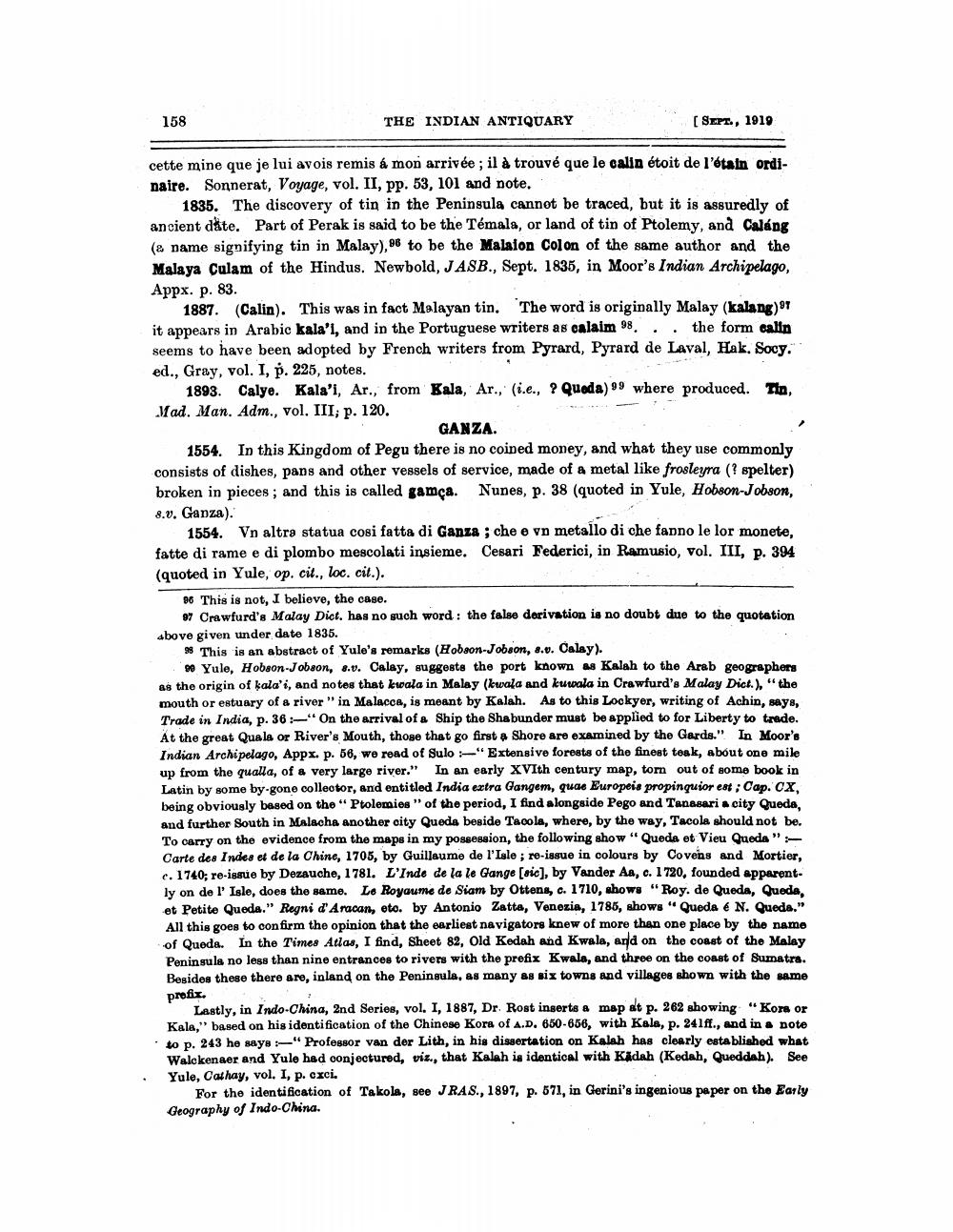________________
158
THE INDIAN ANTIQUARY
[SEPT., 1919
cette mine que je lui avois remis à mon arrivée; il à trouvé que le calin étoit de l'étain ordinaire. Sonnerat, Voyage, vol. II, pp. 53, 101 and note.
1835. The discovery of tin in the Peninsula cannot be traced, but it is assuredly of ancient date. Part of Perak is said to be the Témala, or land of tin of Ptolemy, and Caláng (a name signifying tin in Malay), 96 to be the Malaion Colon of the same author and the Malaya Culam of the Hindus. Newbold, JASB., Sept. 1835, in Moor's Indian Archipelago, Appx. p. 83.
1887. (Calin). This was in fact Malayan tin. The word is originally Malay (kalang)9 it appears in Arabic kala'i, and in the Portuguese writers as calaim 98... the form calin seems to have been adopted by French writers from Pyrard, Pyrard de Laval, Hak. Socy. ed., Gray, vol. I, p. 225, notes.
1893. Calye. Kala'i, Ar., from Kala, Ar., (i.e., ? Queda) 99 where produced. Tin, Mad. Man. Adm., vol. III; p. 120.
GANZA.
1554. In this Kingdom of Pegu there is no coined money, and what they use commonly consists of dishes, pans and other vessels of service, made of a metal like frosleyra (? spelter) broken in pieces; and this is called gamça. Nunes, p. 38 (quoted in Yule, Hobson-Jobson, 8.v. Ganza).
1554. Vn altra statua cosi fatta di Ganza; che e vn metallo di che fanno le lor monete, fatte di rame e di plombo mescolati insieme. Cesari Federici, in Ramusio, vol. III, p. 394 (quoted in Yule, op. cit., loc. cit.).
96 This is not, I believe, the case.
97 Crawfurd's Malay Dict. has no such word: the false derivation is no doubt due to the quotation above given under date 1835.
98 This is an abstract of Yule's remarks (Hobson-Jobson, s.v. Calay).
99 Yule, Hobson-Jobson, s.v. Calay, suggests the port known as Kalah to the Arab geographers as the origin of kala'i, and notes that kwala in Malay (kwala and kuwala in Crawfurd's Malay Dict.), "the mouth or estuary of a river" in Malacca, is meant by Kalah. As to this Lockyer, writing of Achin, says, Trade in India, p. 36: On the arrival of a Ship the Shabunder must be applied to for Liberty to trade. At the great Quala or River's Mouth, those that go first a Shore are examined by the Gards." In Moor's Indian Archipelago, Appx. p. 56, we read of Sulo:" Extensive forests of the finest teak, about one mile up from the qualla, of a very large river." In an early XVIth century map, torn out of some book in Latin by some by-gone collector, and entitled India extra Gangem, quae Europeis propinquior est; Cap. CX, being obviously based on the "Ptolemies" of the period, I find alongside Pego and Tanasari a city Queda, and further South in Malacha another city Queda beside Tacola, where, by the way, Tacola should not be. To carry on the evidence from the maps in my possession, the following show "Queda et Vieu Queda" : Carte des Indes et de la Chine, 1705, by Guillaume de l'Isle ; re-issue in colours by Covens and Mortier, c. 1740; re-issue by Dezauche, 1781. L'Inde de la le Gange [sic], by Vander Aa, c. 1720, founded apparently on de l' Isle, does the same. Le Royaume de Siam by Ottens, c. 1710, shows "Roy. de Queda, Queda, et Petite Queda." Regni d'Aracan, etc. by Antonio Zatta, Venezia, 1785, shows "Queda é N. Queda." All this goes to confirm the opinion that the earliest navigators knew of more than one place by the name of Queda. In the Times Atlas, I find, Sheet 82, Old Kedah and Kwala, and on the coast of the Malay Peninsula no less than nine entrances to rivers with the prefix Kwala, and three on the coast of Sumatra. Besides these there are, inland on the Peninsula, as many as six towns and villages shown with the same prefix.
Lastly, in Indo-China, 2nd Series, vol. I, 1887, Dr. Rost inserts a map at p. 262 showing "Kora or Kala," based on his identification of the Chinese Kora of A.D. 650-656, with Kala, p. 241ff., and in a note to p. 243 he says:-"Professor van der Lith, in his dissertation on Kalah has clearly established what Walckenaer and Yule had conjectured, viz., that Kalah is identical with Kädah (Kedah, Queddah). See Yule, Cathay, vol. I, p. exci.
For the identification of Takola, see JRAS., 1897, p. 571, in Gerini's ingenious paper on the Early Geography of Indo-China.




